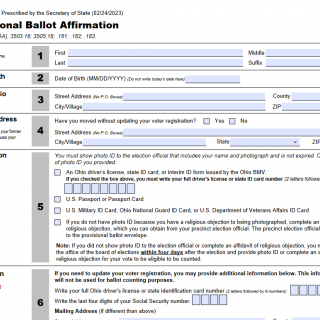Provisional Ballot Form
The Provisional Ballot Form is a form used in the United States to allow a voter whose eligibility is in question to cast a ballot that is later reviewed to determine whether it should be counted.
The form consists of several parts, including personal information about the voter, such as their name, address, and date of birth. It also includes information about the election for which the voter is casting a provisional ballot, such as the election date and the voter's precinct. Additionally, the form includes a section for the voter to explain why their eligibility is in question, and a signature section to validate the application.
The most important fields on the form are typically the ones that include the voter's personal information, as well as their signature and the reason for the provisional ballot. These fields are crucial for the election officials to verify the voter's identity and determine whether the ballot should be counted.
The Provisional Ballot Form is compiled by registered voters whose eligibility to vote is in question, such as if their name is not on the voter roll, or if they do not have the required identification. The parties to the document are the voter and the election officials responsible for processing the provisional ballot and determining whether it should be counted.
When compiling the form, it is important to ensure that all information provided is accurate and up-to-date, as any errors or discrepancies could result in the ballot being rejected. Additionally, the voter should be sure to sign the form and provide a clear explanation of why their eligibility is in question.
The advantages of the Provisional Ballot Form are that it provides a way for voters to cast a ballot, even if their eligibility is in question, and ensures that their vote is counted if it is later determined that they are eligible to vote. It also helps to prevent voter suppression and ensures that all eligible voters have the opportunity to participate in the election process.
However, there can be potential problems when filling out the form, such as providing incomplete or inaccurate information or missing the deadline to submit the form. Additionally, there have been concerns about the potential for provisional ballots to be rejected or not counted, which could affect the outcome of the election.
Related forms include the Affirmation of Voter Eligibility Form, which is used by voters to affirm that they are eligible to vote, and the Voter Registration Form, which is used to register to vote in the first place.
The alternative form is the regular ballot, which is cast by eligible voters whose eligibility is not in question.
The Provisional Ballot Form is typically submitted to the election official responsible for processing provisional ballots in the voter's county or state. The form may be submitted in-person on Election Day or afterwards, depending on the requirements of the jurisdiction. Once the form is processed and reviewed, the decision on whether to count the ballot is made by the election officials. The instances of the form are stored by the election officials for a certain period of time, according to the laws and regulations of the jurisdiction.

